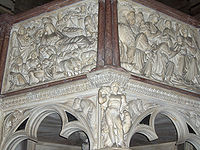Niccolò Pisano




Nicola Pisano , also Niccolò Pisano (* 1210/20 in Pisa or Apulia ; † 1278/87), was an Italian sculptor and architect . He gave Italian sculpture a new impetus, which eventually led to a perfect bloom in the Renaissance.
Life
Pisano, son of a stonemason , probably learned in the southern Italian sculpture workshop, which was connected to the court culture of Frederick II, possibly around the circle of Niccolò di Bartolommeo da Foggia, from whom u. a. the pulpit for Ravello comes from. Around 1250 he went to Pisa (name!), Where his workshop had an order to make a pulpit. This was completed in 1260 and was the first significant Italian pulpit of its kind. His main sculptural works are therefore the polygonal marble pulpits (hexagon) in the Baptistery of Pisa, and also for the Cathedral of Siena (1265–68) with an octagonal floor plan, the parapets with figurative reliefs from the New Testament . In addition, Pisano decorated the grave monument of St. Dominic in Bologna, the Arca di San Domenico , with reliefs and the marble fountain ( Fontana Maggiore ) in Perugia (1277–1280) with reliefs and statuettes, which have the monthly cycles as well as the seven liberal arts as their theme, and began building the baptistery in Pisa in 1260 .
His students were Arnolfo di Cambio and Fra Guglielmo Agnelli , as well as Pisano's son, Giovanni Pisano , who helped build the pulpit and created important works after him and even became a master builder.
The fountain in Pistoia , made after 1270, was made by the employees Donato and Lapo according to his designs. The fountain in Perugia's cathedral square is also a joint project, together with Giovanni, his son, and Arnolfo di Cambio. Pisano towered far beyond its immediate predecessors.
Although he also retained the traditional, predominantly Byzantine composition motifs; However, by studying antiquity, especially the late antique sarcophagus sculpture, he gave the impetus to a new formation of forms, which he applied in relief, whereby the design of plastic forms gained importance over the floor plan. The pulpits and fountains in general, but especially the reliefs, contain a rich iconographic program. The high reliefs are densely filled with calmly moving and naturally designed figures, which are based on the direct study of nature. Pisano's unique feeling for physical modeling was evident in these reliefs and corresponds to the awakening feeling for human dignity in the Renaissance with the increasing self-confidence of the bourgeoisie.
We are not very well informed about Pisano as an architect, since almost all of the buildings ascribed to him in Vasari's Viten have been rebuilt over time. A definite proof of participation in the church of S. Trinità in Florence or the castle in Prato remains unclear.
literature
- Georg Swarzenski : Nicolo Pisano , Frankfurt 1926.
- Joachim Poeschke : The sculpture of the Middle Ages in Italy. Volume 2: Gothic. Hirmer, Munich 1998, ISBN 3-7774-8400-8 .
- Francesco Aceto: NICOLA Pisano. In: Raffaele Romanelli (ed.): Dizionario Biografico degli Italiani (DBI). Volume 78: Natta – Nurra. Istituto della Enciclopedia Italiana, Rome 2013.
- M. Wundram: NICOLA PISANO. In: Enciclopedia dell'Arte Medievale (1997)
Web links
- List of works (selection) by Pisano Nicola from the Fondazione Zeri of the University of Bologna
- Nicòla Pisano (o Nicola d'Apùlia) at Enciclopedie on line Treccani
Individual evidence
- ↑ In the 19th century there was uncertainty about his ancestry. It was referred to in documents as de Apulia , but this could also have referred to local villages; however, its first recorded appearance took place in Pisa. Compare Pulìa Lucchese, the alleged birthplace of Nicola's Pisano (Wikisource) If he comes from Apulia, an education in the Apulian sculpture school of Emperor Frederick II would be obvious, who had given his stonemasons for the first time the reference to the profane sculpture of antiquity, for example with the sculptural jewelry of Capua Bridge Gate .
- ^ Giorgio Vasari: Le vite dei più eccellenti pittori, scultori e architetti. Newton Compton Editori, Rome 2010, ISBN 978-88-541-1425-8 , p. 127 ff.
| personal data | |
|---|---|
| SURNAME | Pisano, Niccolò |
| ALTERNATIVE NAMES | Pisano, Nicola |
| BRIEF DESCRIPTION | Italian sculptor and architect |
| DATE OF BIRTH | between 1205 and 1207 |
| PLACE OF BIRTH | Pisa or Puglia |
| DATE OF DEATH | 1278 |
